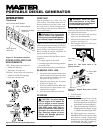
8
107359
PORTABLE DIESEL GENERATOR
R
STANDBY
INSTALLATION TO
HOME OR
BUILDING
WARNING: Have standby in-
stallation performed by a skilled,
licensed electrician. Do not let
anyone else wire into a utility
circuit. Personal injury, equip-
ment damage, or damage to home
could occur.
IMPORTANT:
This generator will not
power your entire home. Most home utility
electric service is more than 60 amps. This
will exceed generator output. Only power
needed items during a power outage. Make
sure total wattage of electrical load does not
exceed rated wattage of generator.
You may need to use this generator as a
standby power source. During a power out-
age, the generator will power selected items
in a building. Have generator and additional
wiring installed by a skilled, licensed elec-
trician. This is not a do-it-yourself job. Fol-
low all local codes.
DETERMINING
ELECTRICAL LOAD
FOR GENERATOR
You must decide what electrical load your
generator can power. Do this before using
generator. Use the following four-step
method. It will help you select a load that is
not too large. Make sure total wattage of all
electrical loads does not 5,000 watts. Elec-
tric motors present a special problem when
figuring load. Read step 3 carefully.
1. Make two lists of items you want pow-
ered by generator. List all motors and
motor powered appliances in one. List all
lights, small appliances, etc. in the other.
For standby service to home or building,
only include items you must power.
2. Enter running watts of each item ex-
cept motors. The light bulb or appli-
ance nameplate lists its wattage. Re-
member, 1KW = 1000 watts.
Note:
The
nameplate may not list wattage. It may
only list volts and amps. The formula
for finding wattage is: Volts x Amps =
Watts. For example: An appliance
nameplate states 3 amps at 120 volts. 3
amps x 120 volts = 360 watts.
3. Electric motors present a special
problem. They require up to three-
times their rated wattage to start.
Chart 2, page 9, shows starting watts
for different size motors. For ex-
ample: an electric motor nameplate
states 5 amps at 120 volts. 5 amps x
120 volts = 600 watts running. Mul-
tiply this figure by 3. This will show
the starting watts needed. 600 watts
x 3 = 1800 watts to start. When fig-
uring the generator load for motors,
you must use the starting watts fig-
ure. Do not use the running watts fig-
ure.
Note:
Some motors require
nearly the same wattage to run as to
start. These items include saws,
drills, hair dryers, and food mixers.
See Chart 1, page 9, for typical ap-
pliance wattage examples.
4. Add watts and starting watts of all
items. This total must not be larger
than 5,000 watts. It is a good idea to
have up to 25% extra capacity for
future needs or extra equipment.
Ampere AWG for Length of
Load Cord in Feet
50' 100' 150'
2181818
3181818
4161616
5161616
6161614
8161412
10 16 14 12
12 14 14 12
14 14 12 10
16 12 12 10
20 10 10 8
EXTENSION
CORDS
Only use grounded extension cords. Be sure
to use extension cord with proper wire gauge
size. See chart below.
Recommended Minimum Wire
Gauges (AWG) for Extension
Cords
WARNING: The electrician
must install a double-throw trans-
fer switch. This isolates existing
electrical circuits from the utility
power line. If not isolated, gen-
erator output will back-feed into
utility power line. This may elec-
trocute a power company line
repair person.


















